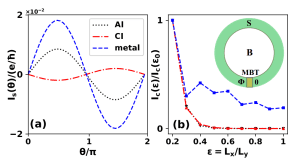 The antiferromagnetic topological insulator MnBi2Te4 features lots of exotic physical phenomena at low temperatures, forging a new direction that joins topological materials with magnetic materials. Yet a missing ingredient in the grand inquiry into antiferromagnetic topological insulators is how the antiferromagnetic behavior can manifest in the quantum tunneling, which has wide applications in quantum computing and related applications. To this end, PI-Cheng’s group studied the transport properties of a Josephson junction consisting of two identical s-wave superconductors separated by an even-layer MnBi2Te4. By numerically calculating the supercurrent in the presence of a perpendicular magnetic field, PI-Cheng found that the quantum interference in such a device setup exhibits distinct patterns when the MnBi2Te4 is in different magnetic states. In its antiferromagnetic state, the MnBi2Te4 is an axion insulator supporting an extended “hinge” supercurrent, which leads to a sinusoidal interference pattern decaying with the field strength. In the ferromagnetic state, on the other hand, the MnBi2Te4 is a Chern insulator and the unbalanced chiral supercurrents on opposite edges give rise to a highly asymmetric interference pattern. If the MnBi2Te4 turns into a metal as the Fermi level is tuned into the conduction band, the interference exhibits a Fraunhofer pattern due to the uniformly distributed bulk supercurrent. This work unravels a strong indicator to identify different phases in MnBi2Te4 and can be verified directly by experiments.
The antiferromagnetic topological insulator MnBi2Te4 features lots of exotic physical phenomena at low temperatures, forging a new direction that joins topological materials with magnetic materials. Yet a missing ingredient in the grand inquiry into antiferromagnetic topological insulators is how the antiferromagnetic behavior can manifest in the quantum tunneling, which has wide applications in quantum computing and related applications. To this end, PI-Cheng’s group studied the transport properties of a Josephson junction consisting of two identical s-wave superconductors separated by an even-layer MnBi2Te4. By numerically calculating the supercurrent in the presence of a perpendicular magnetic field, PI-Cheng found that the quantum interference in such a device setup exhibits distinct patterns when the MnBi2Te4 is in different magnetic states. In its antiferromagnetic state, the MnBi2Te4 is an axion insulator supporting an extended “hinge” supercurrent, which leads to a sinusoidal interference pattern decaying with the field strength. In the ferromagnetic state, on the other hand, the MnBi2Te4 is a Chern insulator and the unbalanced chiral supercurrents on opposite edges give rise to a highly asymmetric interference pattern. If the MnBi2Te4 turns into a metal as the Fermi level is tuned into the conduction band, the interference exhibits a Fraunhofer pattern due to the uniformly distributed bulk supercurrent. This work unravels a strong indicator to identify different phases in MnBi2Te4 and can be verified directly by experiments.
This article was published in Physical Review Research and is available here.
